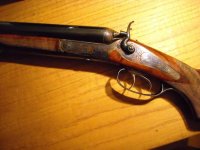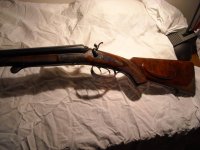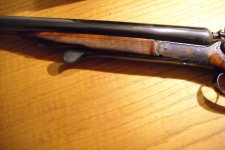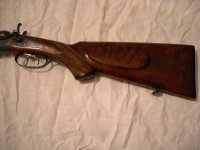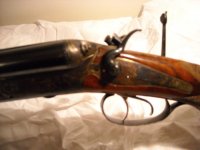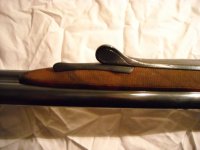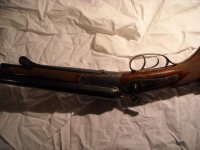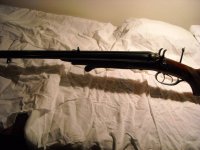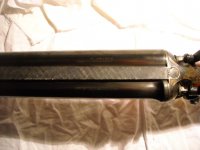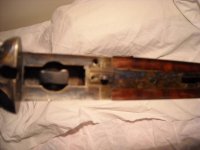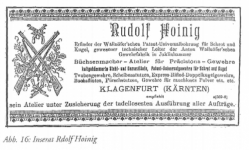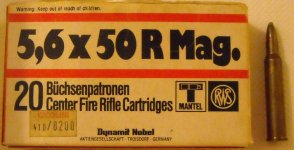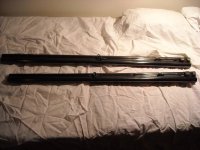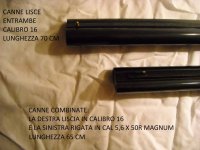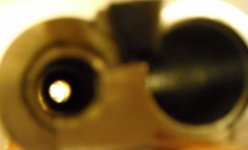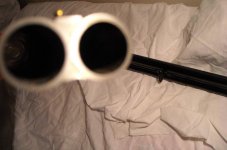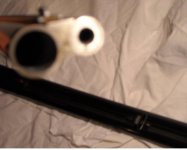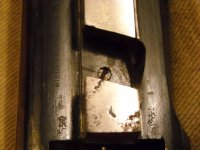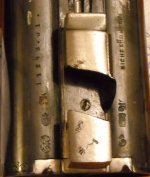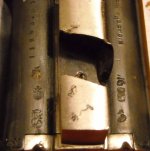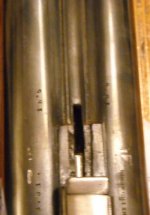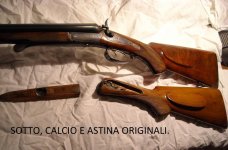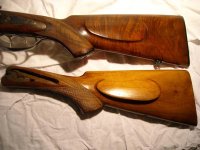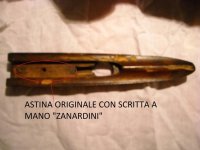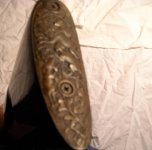Salve a tutti,
vi scrivo per sapere qualcosa di più su questa doppietta austriaca con 2 paia di canne: la prima coppia è marchiata R.HOINIG IN KLAGENFURT ed è un combinato, cal.16 e 5,6, le canne sono lunghe 65 cm. L'altra coppia ha entrambe le canne lisce in cal.16 e non riporta il marchio di fabbrica e le canne sono di 70 cm.
Questa doppietta, ricevuta molti anni fa in regalo da un amico che aveva lavorato per molto tempo a Bolzano, l'ho a suo tempo fatta restaurare perfettamente dalla Famars con una spesa importante: sono stati sostituiti il calcio e l'astina con legni stagionatissimi scelti e le canne sono state lappate e ribrunite, ripasso incisioni e tanti altri lavori... insomma ora è perfettamente efficiente. Ha delle ottime chiusure.
Le sue particolarità sono la chiusura a testa di bambola tonda, il mirino alzabile posto tra i due cani esterni e la chiave di apertura del tipo a T sotto l'asta.
Guardando i punzoni (ho confrontato vari siti al merito, quello più dettagliato mi è sembrato quello di Edoardo Mori, ma ci sono molti punti che non tornano) si nota che è stata fatta a Ferlach, sembrerebbe prodotta tra il 1891 e il 1940, se si scende nel dettaglio probabilmente prima del 1918, questo lo deduco dal fatto che un sito riporta il punzone aquila a 2 teste con corona indicante l'impero austro-ungarico fino alla fine della Prima guerra mondiale, ma non ho trovato altre informazioni.
Questo artigiano di nome Rudolf Hoinig pare sia stato l'ex direttore tecnico della fabbrica di fucili di Anton Wallnofer a Jaklinhammer a 3 km da Ferlach, e insieme a lui dovrebbe aver brevettato il "fucile da caccia universale", l'antenato dei fucili da caccia di oggi, questo è tutto quello che ho trovato. Su Internet ho trovato solamente altri 2 fucili prodotti da lui.
Ho scattato molte foto, ho cercato di fare il possibile in termini di qualità dell'immagine.
Grazie per l'attenzione.














































































Sulla bascula c'è inciso il n° 343


















punzoni canne combinate:



punzoni canne lisce



Mi incuriosisce questa scritta Zanardini incisa nell'attacco delle canne e scritta a mano nell'astina di legno: si tratterà dell'omonima fabbrica di Gardone nata nel 1946, che magari avrà fatto alcuni lavori o importato questo fucile?
Qui sotto si vede meglio il n° di matricola 11243.01. per le canne lisce e per il combinato 7138.00.
Naturalmente sotto la bindella ci sono tanti altri numeri. Il fucile certamente è nato per le canne combinate perché c'è quel caratteristico alzo, e l'altro paio di lisce sarà stato fatto in seguito, tanto che non ha l'incisione della marca. Non sarà che il numero dopo il punto nella matricola, ovvero 00 sulle canne più vecchie e 01 sulle altre indichi l'anno 1900 per le prime e 1901 per le seconde?








 ho trovato questa pubblicità sul web
ho trovato questa pubblicità sul web



vi scrivo per sapere qualcosa di più su questa doppietta austriaca con 2 paia di canne: la prima coppia è marchiata R.HOINIG IN KLAGENFURT ed è un combinato, cal.16 e 5,6, le canne sono lunghe 65 cm. L'altra coppia ha entrambe le canne lisce in cal.16 e non riporta il marchio di fabbrica e le canne sono di 70 cm.
Questa doppietta, ricevuta molti anni fa in regalo da un amico che aveva lavorato per molto tempo a Bolzano, l'ho a suo tempo fatta restaurare perfettamente dalla Famars con una spesa importante: sono stati sostituiti il calcio e l'astina con legni stagionatissimi scelti e le canne sono state lappate e ribrunite, ripasso incisioni e tanti altri lavori... insomma ora è perfettamente efficiente. Ha delle ottime chiusure.
Le sue particolarità sono la chiusura a testa di bambola tonda, il mirino alzabile posto tra i due cani esterni e la chiave di apertura del tipo a T sotto l'asta.
Guardando i punzoni (ho confrontato vari siti al merito, quello più dettagliato mi è sembrato quello di Edoardo Mori, ma ci sono molti punti che non tornano) si nota che è stata fatta a Ferlach, sembrerebbe prodotta tra il 1891 e il 1940, se si scende nel dettaglio probabilmente prima del 1918, questo lo deduco dal fatto che un sito riporta il punzone aquila a 2 teste con corona indicante l'impero austro-ungarico fino alla fine della Prima guerra mondiale, ma non ho trovato altre informazioni.
Questo artigiano di nome Rudolf Hoinig pare sia stato l'ex direttore tecnico della fabbrica di fucili di Anton Wallnofer a Jaklinhammer a 3 km da Ferlach, e insieme a lui dovrebbe aver brevettato il "fucile da caccia universale", l'antenato dei fucili da caccia di oggi, questo è tutto quello che ho trovato. Su Internet ho trovato solamente altri 2 fucili prodotti da lui.
Ho scattato molte foto, ho cercato di fare il possibile in termini di qualità dell'immagine.
Grazie per l'attenzione.














































































Sulla bascula c'è inciso il n° 343


















punzoni canne combinate:



punzoni canne lisce



Mi incuriosisce questa scritta Zanardini incisa nell'attacco delle canne e scritta a mano nell'astina di legno: si tratterà dell'omonima fabbrica di Gardone nata nel 1946, che magari avrà fatto alcuni lavori o importato questo fucile?
Qui sotto si vede meglio il n° di matricola 11243.01. per le canne lisce e per il combinato 7138.00.
Naturalmente sotto la bindella ci sono tanti altri numeri. Il fucile certamente è nato per le canne combinate perché c'è quel caratteristico alzo, e l'altro paio di lisce sarà stato fatto in seguito, tanto che non ha l'incisione della marca. Non sarà che il numero dopo il punto nella matricola, ovvero 00 sulle canne più vecchie e 01 sulle altre indichi l'anno 1900 per le prime e 1901 per le seconde?













